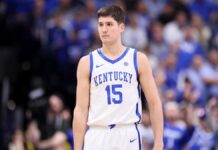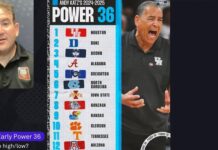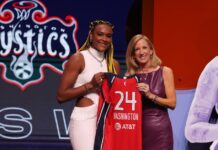After the Atlanta Dream disappointingly dropped their home opener 90-87 to Indiana, permitting the Fever to prevent a WNBA-record 21-game losing streak, head coach Tanisha Wright belabored that her team needed to “do a better job executing the details.”
On Tuesday, the team manifested their coach’s message, putting together their most precise performance of the young season to score an inspiring 83-65 victory over the Sky, their first win against Chicago since 2018.
It’s worth analyzing the ways in which the Dream “execut[ed] the details,” not simply to explain their success against Chicago (which, admittedly, was missing two key cogs with injuries to Rebekah Gardner and Morgan Bertsch) but also to understand how the processes they demonstrated can allow Atlanta to consistently approach their upside and achieve their postseason ambitions.
While the Dream dialed in their defense to stymie the Sky’s perimeter scoring trio of Kahleah Copper, Marina Mabrey and Courtney Williams, Atlanta’s swifter, smarter and (most importantly) sustainable offensive process particularly shined, presenting a stark contrast from the previous three contests.
Pace, pressure produce positive results
How the Dream pushed the pace in transition and semi-transition and pressured the paint and rim really popped.
In prior games, only Allisha Gray consistently attempted to convert defensive stops into offensive scores. Tuesday evening, her teammates joined the party, adopting an intentional, aggressive mindset. The effort of Nia Coffey was especially encouraging. In addition to making her presence known with three blocks (giving her 10 swats for the season, which is tied for the second-best mark in the league), Coffey was a fearless freight train in transition scenarios, charging toward Atlanta’s basket before spraying the ball out to teammates for spot-up opportunities. Atlanta’s bigs — Cheyenne Parker, Monique Billings and Naz Hillmon — also raced down the floor for easy and early offense, exploiting the athletic advantage they will have over most opponents.
Haley Jones likewise found success on the run, whether pushing the ball into the paint herself or hitting it ahead to teammates. After struggling through her first few professional outings, Jones displayed growing confidence and comfort during Tuesday’s game, including registering an impressive rejection of her own.
Through the first three games, Atlanta’s halfcourt offense was uninspiring, featuring too many low-quality threes, tough twos and flailing, no-chance forays into the paint. Generating easier offense through transition thus is a necessity for the Dream. Tuesday, they tallied 21 fast break points, exceeding their previous season high by 10 points. Despite increasing their tempo, Atlanta also avoided sloppiness, with a season-low nine turnovers serving as a sign of sharp focus.
Halfcourt offense, Howard also improve
However, Atlanta also exhibited improved execution in the half court against Chicago, applying the principles of pace and pressure.
After flinging 32 threes in the season opener against Dallas, Atlanta shot only 13 threes on Tuesday, the fewest number of threes attempted by any WNBA team this season. Even as threes are understood as indicative of idealized modern offense, the Dream do not have the personnel to be an elite high-volume 3-point shooting team. Instead, with their size and athleticism at the perimeter positions, the Dream have the ability to create consistent and sustainable offense by getting into the paint, fueling drive-and-kick opportunities or drawing fouls. As Coach Wright emphasized after the game, paint touches “make the game easier.” Against the Sky, the Dream powered their way to a season-high 42 points in the paint and earned 24 free throws, converting 18 of them.
While Aari McDonald impressed zipping into the paint before pinging the ball out to teammates, it was Rhyne Howard who exemplified Atlanta’s better halfcourt offense. The season’s first three games suggested the 2022 Rookie of the Year might be suffering through a sophomore slump. But she looked a lot more like her future superstar self on Tuesday, scoring 20 points as she went 8-of-11 from the field. Although it helped that her 3-ball and midrange fadeaway were falling, Howard displayed the full spectrum of her scoring versatility, not overly relying on superstar shots but, instead, using these shots to complement drives to the hoop that take advantage of her size and athleticism.
Can the Dream keep it up?
Now, Atlanta must maintain this improved process, a task made tougher by the three-game gauntlet — Las Vegas (Friday, June 2 at 8 p.m. ET), New York (Friday, June 9 at 7:30 p.m. ET) and Connecticut (Sunday, June 11 at 4 p.m. ET) — that completes the current, extended five-game home stand.
This daunting schedule can be a blessing in a disguise. Even if the desired results do not come, facing off against the league’s top three teams will productively test the Dream, demanding that they stay attuned to executing the details.













































